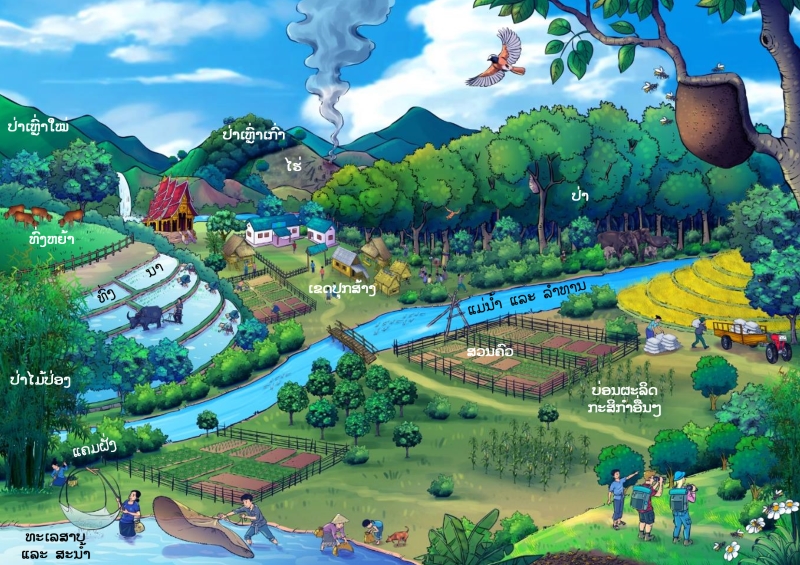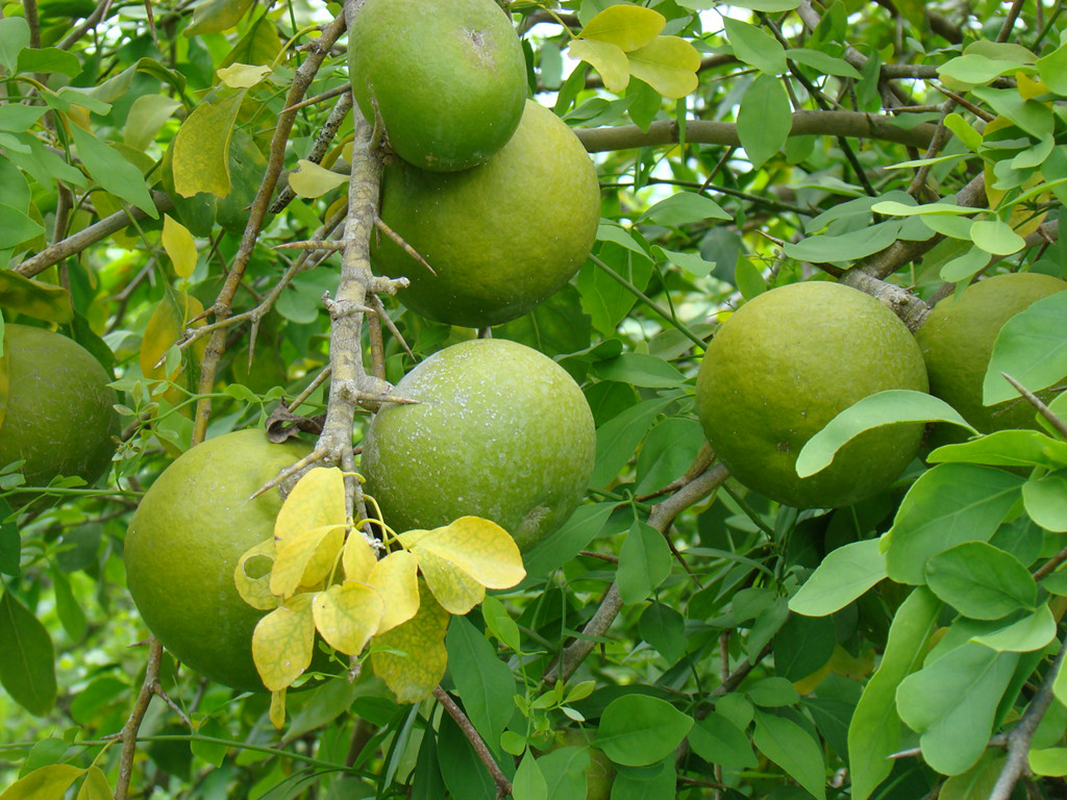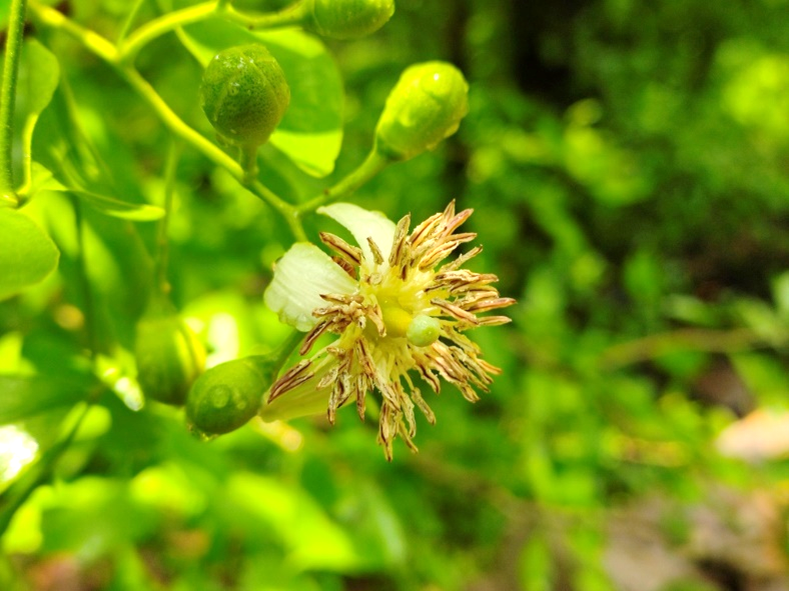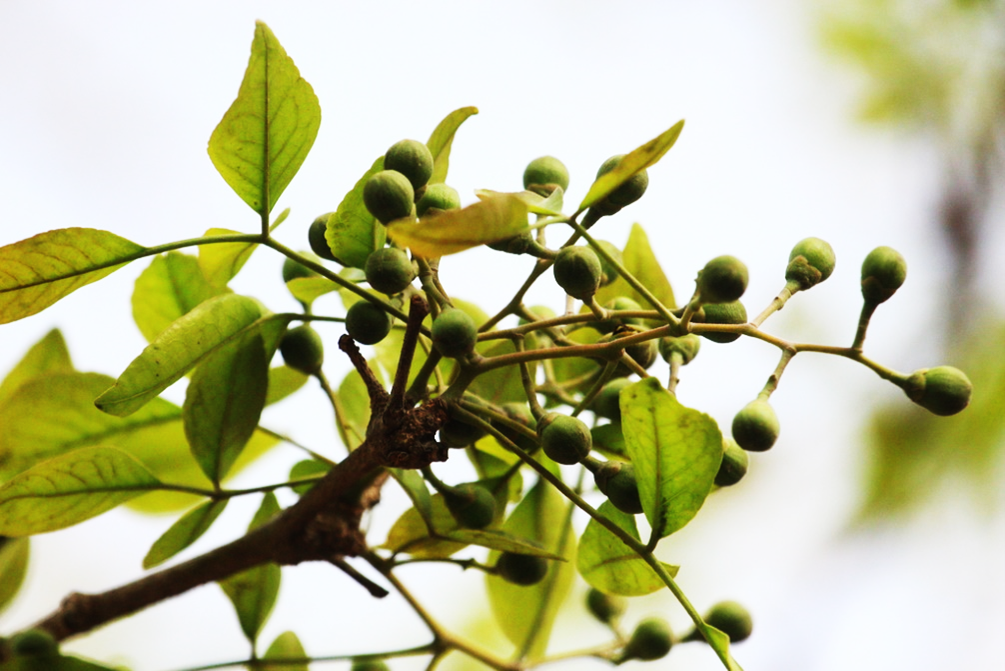ເລກລຳດັບທີ: 813
ລະດັບການຮວບຮວມຂໍ້ມູນ: ຂໍ້ມູນພື້ນຖານ
ປັບປູງຄັ້ງລ່າສຸດ: N/A
ຕົ້ນໝາກຕູມ
Bael Fruit
Aegle marmelos (L.) Corrêa
ພືດ
ໄມ້ຢືນຕົ້ນ
ຕົ້ນໄມ້ ແລະ ປາມ
×
ຊື່ທ້ອງຖີ່ນ:
ໝາກເບັງ, ໝາກປິນ
ຊື່ພ້ອງ
:
Aegle marmelos (L.) Corrêa ex Roxb.
Aegle marmelos var. mahurensis Zate
Belou marmelos (L.) Lyons
Bilacus marmelos (L.) Kuntze
Crateva marmelos L.
Crateva religiosa Ainslie
Feronia pellucida B.Heyne
Feronia pellucida B.Heyne ex Roth
Aegle marmelos var. mahurensis Zate
Belou marmelos (L.) Lyons
Bilacus marmelos (L.) Kuntze
Crateva marmelos L.
Crateva religiosa Ainslie
Feronia pellucida B.Heyne
Feronia pellucida B.Heyne ex Roth
ຊື່ສະກຸນ:
Rutaceae
ຊະນິດໃກ້ຄຽງ:
ບັນຍາຍລັກສະນະທາງພືດສາດ:
ຕົ້ນໝາກຕູມ ເປັນຕົ້ນໄມ້ຢືນຕົ້ນທີ່ເຕີບໃຫຍ່ຊ້າ ແລະ ມີຄວາມສູງເຖິງ 12-15 ແມັດ. ມີລັກສະນະລຳຕົ້ນສັ້ນ, ເປືອກໜາ, ເປືອກມີຮອຍແຕກ, ແລະ ກິ່ງງ່າຂອງມັນຈະມີໜາມ. ງ່າ ແລະ ຍອດອ່ອນມີໜາມຢ່າງຫຼວງຫຼາຍ. ເມື່ອຕົ້ນໄມ້ຖືກສິ່ງອື່ນກະທົບໃສ່ ຢາງຂອງມັນຈະໄລ່ອອກມາ, ເຊິ່ງເຮັດໃຫ້ແຂງ ແລະ ເຮັດໃຫ້ເກີດການລະຄາຍເຄືອງຄໍຫຼັງຈາກລອງລົດຊາດຫວານໃນເບື້ອງຕົ້ນ.
ຕົ້ນໄມ້ນີ້ມີໃບປ່ຽນໃບທີ່ຫຼົ່ນລົງຕາມລະດູການ. ມີໃບຍ່ອຍເປັນກຸ່ມດ່ຽວ ຫຼື ເປັນກຸ່ມ 2 ຫຼື 3 ໃບ. ແຕ່ລະໃບປະກອບດ້ວຍໃບຍ່ອຍຮູບໄຂ່ປາຍແຫຼມ 3 ຫາ 5 ໃບ. ໃບຍ່ອຍຍາວ 4-10 ຊມ ແລະ ກວ້າງ 2-5 ຊມ. ໃບຍ່ອຍຢູ່ປາຍຍອດມີກ້ານໃບຍາວກວ່າ. ໃບທີ່ເກີດໃໝ່ແມ່ນເຫຼື້ອມເປັນເງົາ ແລະ ມີສີບົວແກມສີມ່ວງ. ໃບທີ່ແກ່ແລ້ວຈະມີກິ່ນເໝັນ ເມື່ອຖືກຍ່ອງໃສ່ກັນ.
ຕົ້ນໝາກຕູມ ຜະລິດດອກທີ່ມີກິ່ນຫອມ, ມີຊໍ່ດອກ 4-7 ດອກ ຕາມກິ່ງງ່າອ່ອນ. ແຕ່ລະດອກມີກີບດອກ 4 ກີບ, ກີບດອກດ້ານນອກມີສີຂຽວ ແລະ ດ້ານໃນເປັນສີເຫຼືອງ. ມີເກສອນຜູ້ສີຂຽວອອກເຫຼືອງ ມີ 50 ອັນ.
ໝາກຂອງມັນເປັນຮູບຮ່າງກົມ, ຄືຮູບໄຂ່ ຫຼື ຮູບຂອບຂະໜານ. ມີເສັ້ນຜ່າກາງ 5-20 ຊມ. ເປືອກບາງ ແລະ ແຂງ ຫຼື ບາງເລັກນ້ອຍ. ເປືອກມີສີຂຽວແກມສີຂີ້ເຖົ່າ ແລະ ເມື່ອສຸກແລ້ວຈະປ່ຽນເປັນສີເຫຼືອງ. ດ້ານໃນຂອງມັນມີແກນແຂງທາງກາງ ແລະ ປ່ຽງສາມຫຼ່ຽມ 8-20 ປ່ຽງ . ແຕ່ລະປ່ຽງມີຝາບາງໆ ເປັນສີສົ້ມເຂັ້ມ ທີ່ເຕັມໄປດ້ວຍກິ່ນຫອມ, ມີລົດຊາດຫວານ, ລົດສົ້ມ ແລະ ຂົມເລັກນ້ອຍ.
ດ້ານໃນເນື້ອຂອງມັນມີ 10-15 ເມັດ. ແຕ່ລະເມັດຍາວປະມານ 1 ຊມ, ແປ ເປັນຮູບໄຂ່, ແລະ ປົກຫຸ້ມດ້ວຍຂົນຂອງມັນ. ຖົງເມືອກມັນໜຽວ, ຫໍ່ຫຸ້ມເມັດແຕ່ລະເມັດແຂງ ເມື່ອມັນແຫ້ງ. ແຫຼ່ງທີ່ມາ: [1]
ຕົ້ນໄມ້ນີ້ມີໃບປ່ຽນໃບທີ່ຫຼົ່ນລົງຕາມລະດູການ. ມີໃບຍ່ອຍເປັນກຸ່ມດ່ຽວ ຫຼື ເປັນກຸ່ມ 2 ຫຼື 3 ໃບ. ແຕ່ລະໃບປະກອບດ້ວຍໃບຍ່ອຍຮູບໄຂ່ປາຍແຫຼມ 3 ຫາ 5 ໃບ. ໃບຍ່ອຍຍາວ 4-10 ຊມ ແລະ ກວ້າງ 2-5 ຊມ. ໃບຍ່ອຍຢູ່ປາຍຍອດມີກ້ານໃບຍາວກວ່າ. ໃບທີ່ເກີດໃໝ່ແມ່ນເຫຼື້ອມເປັນເງົາ ແລະ ມີສີບົວແກມສີມ່ວງ. ໃບທີ່ແກ່ແລ້ວຈະມີກິ່ນເໝັນ ເມື່ອຖືກຍ່ອງໃສ່ກັນ.
ຕົ້ນໝາກຕູມ ຜະລິດດອກທີ່ມີກິ່ນຫອມ, ມີຊໍ່ດອກ 4-7 ດອກ ຕາມກິ່ງງ່າອ່ອນ. ແຕ່ລະດອກມີກີບດອກ 4 ກີບ, ກີບດອກດ້ານນອກມີສີຂຽວ ແລະ ດ້ານໃນເປັນສີເຫຼືອງ. ມີເກສອນຜູ້ສີຂຽວອອກເຫຼືອງ ມີ 50 ອັນ.
ໝາກຂອງມັນເປັນຮູບຮ່າງກົມ, ຄືຮູບໄຂ່ ຫຼື ຮູບຂອບຂະໜານ. ມີເສັ້ນຜ່າກາງ 5-20 ຊມ. ເປືອກບາງ ແລະ ແຂງ ຫຼື ບາງເລັກນ້ອຍ. ເປືອກມີສີຂຽວແກມສີຂີ້ເຖົ່າ ແລະ ເມື່ອສຸກແລ້ວຈະປ່ຽນເປັນສີເຫຼືອງ. ດ້ານໃນຂອງມັນມີແກນແຂງທາງກາງ ແລະ ປ່ຽງສາມຫຼ່ຽມ 8-20 ປ່ຽງ . ແຕ່ລະປ່ຽງມີຝາບາງໆ ເປັນສີສົ້ມເຂັ້ມ ທີ່ເຕັມໄປດ້ວຍກິ່ນຫອມ, ມີລົດຊາດຫວານ, ລົດສົ້ມ ແລະ ຂົມເລັກນ້ອຍ.
ດ້ານໃນເນື້ອຂອງມັນມີ 10-15 ເມັດ. ແຕ່ລະເມັດຍາວປະມານ 1 ຊມ, ແປ ເປັນຮູບໄຂ່, ແລະ ປົກຫຸ້ມດ້ວຍຂົນຂອງມັນ. ຖົງເມືອກມັນໜຽວ, ຫໍ່ຫຸ້ມເມັດແຕ່ລະເມັດແຂງ ເມື່ອມັນແຫ້ງ. ແຫຼ່ງທີ່ມາ: [1]
ນິເວດວິທະຍາ
ເຂດກະຈາຍພັນທົ່ວໂລກ:
Native to: Assam, Bangladesh, India, Nepal, Pakistan, West Himalaya. [2]
ເຂດກະຈາຍພັນໃນລາວ
:
ລຽບແມ່ນ້ຳຂອງພາກເໜືອ
ເຂດລຽບແມ່ນ້ຳຂອງພາກໃຕ້
ເຂດລຽບແມ່ນ້ຳຂອງພາກໃຕ້

ເຂດກະຈາຍພັນຕາມພູມສັນຖານ
:
ປ່າປູກ
ປ່າປະສົມປ່ຽນໃບ
ປ່າໂຄກ
ສວນຄົວ
ປ່າປະສົມປ່ຽນໃບ
ປ່າໂຄກ
ສວນຄົວ

ສະເພາະຖິ່ນໃນລາວ:
ຕ່າງຖິ່ນ
ຮຸກຮານ
:
ບໍ່ຮຸກຮານ
ສະຖານະພາບການອະນູຮັກ IUCN
:
ໃກ້ຖືກຄຸກຄາມ
ສະຖານະພາບການອະນຸຮັກແຫ່ງຊາດລາວ
:
ບັນຊີທີ່ III: ຊະນິດພັນປະເພດທົ່ວໄປ
ການນຳໃຊ້
ປະເພດການນຳໃຊ້:
ອາຫານ
ພືດເປັນຢາ
ເຄື່ອງດື່ມ
ພືດເປັນຢາ
ເຄື່ອງດື່ມ
ບັນຍາຍການນຳໃຊ້:
ອາຫານ: ໝາກສຸກຂອງໝາກຕູມ ສາມາດບໍລິໂພກສົດ ຫຼື ຕາກໃຫ້ແຫ້ງ ແລ້ວເອົາມາເຮັດເປັນເຂົ້າໜົມ, ເຂົ້າໜົມປັງ, ຫຼື ຜົງເນື້ອເຍື່ອ. ມັນມີລົດຊາດຫວານເມື່ອປຸງແຕ່ງເປັນເຄື່ອງດື່ມ ເຊັ່ນ ນ້ຳໝາກໄມ້. [4]
ເຄື່ອງດື່ມ: ນ້ຳໝາກຕູມ ລົດຊາດຂອງມັນຂົມເລັກນ້ອຍ ແລະຫວານ, ຄ້າຍຄືກັບນ້ຳໝາກນາວ. ມັນມັກຈະເປັນເຄື່ອງດື່ມທີ່ດື່ມໃນຊ່ວງອາກາດຮ້ອນ. [4]
ຢາ: ຕົ້ນໝາກຕູມ (Bael) ມີສັບພະຄຸນຫຼາຍຢ່າງ, ລວມທັງຕ້ານການຖອກທ້ອງ, ຕ້ານການຖອກທ້ອງ, ຢາຕ້ານເຊື້ອ, ຢາຕ້ານເຊື້ອ, ຕ້ານມະເຮັງ, ຕ້ານການອັກເສບ, ຕ້ານການອັກເສບ, ປິ່ນປົວບາດແຜ, ຕ້ານສິ່ງທີ່ເປັນຜິດ, ຂັບການຖ່າຍເທທາງປັດສະວະ, ການເກີດລູກ, ແລະ ຕ້ານການອັກເສບ. ການວິໄຈຢ່າງກວ້າງຂວາງຊີ້ໃຫ້ເຫັນທ່າແຮງຂອງມັນໃນການປິ່ນປົວພະຍາດຕ່າງໆ. [5], ໃນປະເທດລາວ, ຍອດອ່ອນຖືກນຳມາໃຊ້ເປັນຜັກ ແລະ ໝາກໄມ້ນັ້ນນຳມາຕາກໃຫ້ແຫ້ງແລ້ວນຳມາປຸງເປັນນ້ຳສະໝຸນໄພ, ສາມາດດື່ມໄດ້ທັງຮ້ອນ ແລະ ເຢັນ, ແກ້ປວດຕາມຮ່າງກາຍ ແລະ ເຮັດໃຫ້ຮູ້ສຶກດີຂຶ້ນ. [6], ຮາກໃຊ້ຕົ້ມ ແລະ ດື່ມແກ້ຮ້ອນພາຍໃນ. ຕົ້ມກິນແກ້ທ້ອງອືດ, ແກ້ໄອ, ຂັບລົມ, ໄລ່ເລືອດ, ແກ້ໄຂ້, ປິ່ນປົວພະຍາດເບົາຫວານ. ຕົ້ມດື່ມເປັນຢາແກ້ຫວັດ, ເປືອກມັນເອົາໄປຄ້າງໄຟແລ້ວນຳມາກິນແກ້ຮ້ອນໃນ, ຕົ້ມນ້ຳດື່ມເພື່ອບຳລຸງກຳລັງ, ແກ້ອາການທ້ອງອືດ. ໃບບຳລຸງທາດໃນການຈະເລີນອາຫານ, ແກ້ພະຍາດກະເພາະລຳໄສ້, ນ້ຳກິນແກ້ພະຍາດຫຼອດລົມອັກເສບ. [7]
ເຄື່ອງດື່ມ: ນ້ຳໝາກຕູມ ລົດຊາດຂອງມັນຂົມເລັກນ້ອຍ ແລະຫວານ, ຄ້າຍຄືກັບນ້ຳໝາກນາວ. ມັນມັກຈະເປັນເຄື່ອງດື່ມທີ່ດື່ມໃນຊ່ວງອາກາດຮ້ອນ. [4]
ຢາ: ຕົ້ນໝາກຕູມ (Bael) ມີສັບພະຄຸນຫຼາຍຢ່າງ, ລວມທັງຕ້ານການຖອກທ້ອງ, ຕ້ານການຖອກທ້ອງ, ຢາຕ້ານເຊື້ອ, ຢາຕ້ານເຊື້ອ, ຕ້ານມະເຮັງ, ຕ້ານການອັກເສບ, ຕ້ານການອັກເສບ, ປິ່ນປົວບາດແຜ, ຕ້ານສິ່ງທີ່ເປັນຜິດ, ຂັບການຖ່າຍເທທາງປັດສະວະ, ການເກີດລູກ, ແລະ ຕ້ານການອັກເສບ. ການວິໄຈຢ່າງກວ້າງຂວາງຊີ້ໃຫ້ເຫັນທ່າແຮງຂອງມັນໃນການປິ່ນປົວພະຍາດຕ່າງໆ. [5], ໃນປະເທດລາວ, ຍອດອ່ອນຖືກນຳມາໃຊ້ເປັນຜັກ ແລະ ໝາກໄມ້ນັ້ນນຳມາຕາກໃຫ້ແຫ້ງແລ້ວນຳມາປຸງເປັນນ້ຳສະໝຸນໄພ, ສາມາດດື່ມໄດ້ທັງຮ້ອນ ແລະ ເຢັນ, ແກ້ປວດຕາມຮ່າງກາຍ ແລະ ເຮັດໃຫ້ຮູ້ສຶກດີຂຶ້ນ. [6], ຮາກໃຊ້ຕົ້ມ ແລະ ດື່ມແກ້ຮ້ອນພາຍໃນ. ຕົ້ມກິນແກ້ທ້ອງອືດ, ແກ້ໄອ, ຂັບລົມ, ໄລ່ເລືອດ, ແກ້ໄຂ້, ປິ່ນປົວພະຍາດເບົາຫວານ. ຕົ້ມດື່ມເປັນຢາແກ້ຫວັດ, ເປືອກມັນເອົາໄປຄ້າງໄຟແລ້ວນຳມາກິນແກ້ຮ້ອນໃນ, ຕົ້ມນ້ຳດື່ມເພື່ອບຳລຸງກຳລັງ, ແກ້ອາການທ້ອງອືດ. ໃບບຳລຸງທາດໃນການຈະເລີນອາຫານ, ແກ້ພະຍາດກະເພາະລຳໄສ້, ນ້ຳກິນແກ້ພະຍາດຫຼອດລົມອັກເສບ. [7]
ການປູກ ການລ້ຽງ:
ປູກ ແລະ ທຳມະຊາດ
ລະດູການເກັບກູ້:
ກໍລະກົດ
ສິງຫາ
ກັນຍາ
ສິງຫາ
ກັນຍາ
ການຕະຫຼາດ ແລະ ຕ່ອງໂສ້ມູນຄ່າ:
N/A
ການຄຸ້ມຄອງຈັດການ
ການຄັດເລືອກສາຍພັນ:
ຄວນລະມັດລະວັງທີ່ສຸດໃນການລືອກແນວພັນແມ່ຂອງຕົ້ນໝາກຕູມ. ສໍາລັບການເລືອກຕົ້ນໝາກຕູມ, ຕ້ອງມີການພິຈາລະນາລັກສະນະພື້ນຖານຄື: (1) ໝາກຕູມຄວນໃຫ້ຜົນຜະລິດສູງຢ່າງຕໍ່ເນື່ອງ (2) ຄຸນນະພາບຂອງໝາກຕູມຕ້ອງດີກັບທຸກລັກສະນະທີ່ຕ້ອງການ (3) ໝາກຕູມຄວນເປັນພືດທີ່ບໍ່ມີພະຍາດ ແລະ ສັດຕູພືດ (. 4) ໝາກຕູມຄວນຢູ່ໃນຂັ້ນຕອນຂອງການອອກຫມາກເຕັມທີ່.[8]
ການກຽມພື້ນທີ່:
ການທົດສອບ ແລະ ການປັບປຸງດິນ: ໝາກຕູມຈະເລີນເຕີບໂຕໄດ້ດີແມ່ນໃນດິນຫຼາຍປະເພດ, ລວມທັງດິນດ່າງ, ດິນຫີນ, ດິນເຄັມ, ດິນໂຊດຽມ ແລະ ດິນຊາຍທີ່ມີ pH 5.0-10.0. ພືດຊະນິດນີ້ມັກດິນຊາຍທີ່ມີການລະບາຍນໍ້າໄດ້ດີ ແຕ່ສາມາດເຕີບໃຫຍ່ໃຫ່ຍໄດ້ໃນສະພາບທີ່ບໍ່ເອື້ອອຳນວຍ ເຊັ່ນ: ພື້ນທີ່ດິນເສຍ ຫຼື ເປົ່າວ່າງ. ໝາກຕູມ ເປັນພືດທີ່ທົນທານຕໍ່ອຸນຫະພູມສູງ ແລະ ຄວາມຊຸ່ມຊື່ນຕ່ຳໂດຍສະເພາະໃນຊ່ວງໃນລະດູຮ້ອນໃບໄມ້ຫຼົ່ນ. ສະພາບອາກາດທີ່ ເໝາະສົມແມ່ນເຂດອະນຸພາກ ເຂດຮ້ອນທີ່ມີລະດູຮ້ອນ ແລະ ລະດູໜາວ ທີ່ບໍ່ຮຸ່ນແຮງ ແລະ ມັນສາມາດເຕີບໃຫຍ່ໄດ້ຢູ່ໃນເຂແຫ້ງແລ້ງ ແລະເຂດຮ້ອນພາຍໃຕ້ເງື່ອນໄຂທີ່ມີຝົນ. ຕົ້ນໄມ້ອ່ອນແມ່ນຕ້ອງການອຸນຫະພູມຕໍ່າກວ່າ 40 ອົງສາເຊ ແລະ ມີຄວາມອ່ອນໄຫວຕໍ່ກັບອາກາດໜາວເຢັນໃນລະດູໜາວ.[8]
ການຄຸ້ມຄອງຊົນລະປະທານ: ໃນການປູກ ໝາກຕູມ ພາຍໃຕ້ສະພາບທີ່ນຳໃຊ້ນໍ້ຳຝົນເປັນຫຼັກນັ້ນ, ໂດຍທົ່ວໄປແລ້ວ, ຊົນລະປະທານແມ່ນບໍ່ຄ່ອຍໄດ້ໃຊ້, ແຕ່ການໃຊ້ຊົນລະປະທານມັນກໍ່ສາມາດຈະເລີນເຕີບໂຕໃນໄລຍະການຕັ້ງຕົວຂອງພືດ ແລະ ໃນຊ່ວງລະດູຮ້ອນ. ຕົ້ນໝາກຕູມທີ່ເປັນໄມ້ອ່ອນແມ່ນຕ້ອງການຊົນລະປະທານ 8-10 ຄັ້ງຕໍ່ປີ, ໃນຂະນະທີ່ຕົ້ນໄມ້ທີ່ມີໝາກກຳລັງເຕີບໂຕແມ່ນຕ້ອງການຊົນລະປະທານ 4-5 ຄັ້ງ ໃນຊ່ວງລະຫວ່າງໝາກໄມ້ກໍາລັງຈະເລີນເຕີບໂຕ. ຫຼີກເວັ້ນການໃຫ້ນ້ຳຫຼາຍເກີນໄປ ແລະ ບໍ່ສະໝໍ່ຳສະເໝີ ເພື່ອປ້ອງກັນບໍ່ໃຫ້ໝາກແຕກໄດ້ງ່າຍ ໃນພື້ນທີ່ແຫ້ງແລ້ງ, ໃຫ້ໃຊ້ເຕັກນິກການຈັດການນ້ຳ ແລະ ປົກຄຸ້ມດ້ວຍຫຍ້າເພື່ອຮັກສາຄວາມຊຸ່ມຊື່ນ. ແນະນຳໃຫ້ໃຊ້ລະບົບຊົນລະປະທານແບບໃຫ້ນ້ຳຍ້ອຍ ເພື່ອເພີ່ມປະສິດທິພາບການສະໜອງນ້ຳ ແລະ ເພີ່ມປະສິດທິພາບໃນການຄຸ້ມຄອງທີ່ເຫມາະສົມ. ໝາກຕູມ ສາມາດຈະເລີນເຕີບໂຕໄດ້ໂດຍບໍ່ໃຊ້ຊົນລະປະທານໃນພື້ນທີ່ທີ່ມີອາກາດຮ້ອນ, ຊຸ່ມຊື່ນ ແລະ ແຫ້ງແລ້ງ.[8]
ເທັກນິກການປູກ:
ການກ້າເບ້ຍ: ການກ້າເບ້ຍຂອງໝາກຕູມ ແມ່ນຕ້ອງໃຊ້ເວລາ 7-8 ປີຈຶ່ງຈະອອກດອກ, ໃນຂະນະທີ່ຕົ້ນກ້າຈະອອກດອກເມື່ອຮອດ 3 ປີ. ການອອກດອກແມ່ນເກີດຂື້ນໃນເດືອນເມສາ ຫາ ເດືອນມິຖຸນາ, ຈະມີໝາກໃນທ້າຍເດືອນພຶດສະພາ ຫາ ເດືອນກໍລະກົດ. ໄລຍະເວລາອອກດອກອາດຈະແຕກຕ່າງກັນໄປຕາມສະພາບອາກາດກະສິກໍາ ແລະ ອົງປະກອບທາງພັນທຸກໍາຂອງພືດ.[8]
ການປູກ:ສຳລັບການປູກຕົ້ນໝາກຕູມ ແມ່ນໃຫ້ຂຸດຂຸມຂະໜາດ 1 ແມັດ x 1 ແມັດ x 1 ແມັດ, ແລ້ວເອົາໄປຕາກແດດເພື່ອຂ້າເຊື້ອພະຍາດໃນດິນ ແລະ ເພື່ອຖ່າຍເທການລະບາຍອາກາດ. ເພີ່ມດິນຊັ້ນເທິງເພື່ອປະສົມກັບຝຸ່ນຄອກ 20-25 ກິໂລ ເອົາລົງໃນຂຸມທີ່ຂຸດໄວ້ປະສົມ ຄໍໄພຣີ ຟອດສ (3 ມລ/ລິດ) ເພື່ອປ້ອງກັນສັດຕູພືດ, ໃຫ້ປະສົມດິນຊາຍກັບຝຸ່ນຄອກ ແລະ ດິນຊັ້ນເທິງເພື່ອການລະບາຍອາກາດໄດ້ດີຂຶ້ນ.
ເວລາປູກໝາກຕູມທີ່ເໝາະສົມໃນຊ່ວງລະດູຝົນແມ່ນ ເດືອນມິຖຸນາ, ຫຼັງຈາກຝົນຊ່ວງມໍລະສຸມທໍາອິດໄດ້ຜ່ານໄປ. ໃຫ້ປູກຕົ້ນໝາກຕູມ ຢູ່ໃນໄລຍະຫ່າງ 5 ມ - 8 ມ, ແມ່ນຂຶ້ນກັບແນວພັນ ແລະ ສະພາບອາກາດທາງກເສດ. ສໍາລັບພືດທີ່ຂະຫຍາຍພັນໂດຍບໍ່ມີການນໍາໃຊ້ດິນຂອງແນວພັນເຕ້ຍ. ເຊັ່ນ Gomayashi ໃນລະບົບນິເວດເຄິ່ງແຫ້ງແລ້ງທີ່ມີສະພາບອາກາດຮ້ອນ. ໃຊ້ໄລຍະຫ່າງ 5 x 5 ແມັດ. [8]
ການຂະຫຍາຍພັນພືດ: ປົກກະຕິແລ້ວ, ໝາກຕູມ ຈະຂະຫຍາຍພັນດ້ວຍແກ່ນ, ແຕ່ວິທີການນີ້ມັກຈະສົ່ງຜົນໃຫ້ພືດທີ່ໄດ້ມາບໍ່ຕົງກັບສິ່ງທີ່ຕ້ອງການເມັດພັນ. ດັ່ງນັ້ນ, ການຂະຫຍາຍພັນດ້ວຍແກ່ນແມ່ນໃຊ້ໃນການລ້ຽງຮາກ. ການປູກຕົ້ນໝາກຕູມທີ່ກົງກັບແນວພັນແມ່ນຜະລິດດ້ວຍວິທີການຂະຫຍາຍພັນແບບໂດຍບໍ່ສືບພັນ ເຊັ່ນ: ການອອກດອກ, ການຕໍ່ກິງ, ການຕອນກິງ ແລະ ການດູດຮາກ. ປະຈຸບັນ, ການຕໍ່ກິງ ແລະ ການຕອນກິງດ້ວຍໄມ້ອ່ອນແມ່ນວິທີທາງການຄ້າທົ່ວໄປສຳລັບການປູກໝາກຕູມ.[8]
ການເບິ່ງແຍງ ແລະ ບຳລຸງຮັກສາ:
ໂດຍທົ່ວໄປແລ້ວ ຈະບໍ່ໄດ້ຕັດແຕ່ງກິ່ງເມື່ອພວກມັນເລີ່ມອອກໝາກແລ້ວ, ຍົກເວັ້ນເມື່ອໂຕທີ່ອອກດອກແລ້ວເພື່ອໃຫ້ມີໄລຍະຫ່າງທີ່ດີຂຶ້ນ. ໃນໄລຍະຕົ້ນຂອງການປູກຕົ້ນໝາກຕູມ ໂດຍສະເພາະແມ່ນການປູກທີ່ມີຄວາມໜາແໜ້ນສູງ, ການຕັດແຕ່ງກິ່ງແມ່ນມີຄວາມຈໍາເປັນ. ຕັດແຕ່ງກິ່ງ 75% ຂອງການຈະເລີນເຕີບໂຕປະຈໍາປີ ໃນໄລຍະທີ່ບໍ່ມີໃບເພື່ອກະຕຸ້ນໃຫ້ເກີດກິ່ງງ່າໃໝ່ ແລະ ສ້າງເປັນເຮືອນຮົ່ມທີ່ໜາແໜ້ນເພື່ອປ້ອງກັນຈາກແສງແດດ. ຕັດແຕ່ງກິ່ງທີ່ແຫ້ງມາໄວ້ລວມກັນ ແລະ ກິ່ງທີ່ຕິດເຊື້ອອອກຈາກກັນເພື່ອການເກັບກ່ຽວໝາກຕູມໃຫ້ງ່າຍຂຶ້ນ.[8]
ການປົກປ້ອງ ແລະ ການກຳຈັດສັດຕູພືດ:
ພະຍາດທົ່ວໄປ: ໂດຍທົ່ວໄປແລ້ວ ຕົ້ນໝາກຕູມ ແມ່ນຄວາມທົນທານຕໍ່ພະຍາດຮ້າຍແຮງ, ແຕ່ສາມາດຮັບກະທົບຈາກພະຍາດຕ່າງໆ ເຊັ່ນ: ຂີ້ຝຸ່ນ, ໂລກນ້ຳຄ້່າງ ແລະ ໂລກແຜ່ໃນໝາກຕູມ. ພະຍາດເຫຼົ່ານີ້ສາມາດຈັດການໄດ້ໂດຍການເອົາສ່ວນທີ່ຖືກຕິດເຊື້ອອອກ ຫຼື ໃຊ້ສີດສານເຄມີ.[8]
ການເກັບກ່ຽວ:
ການເບີ່ງແຍງທີ່ຖືກຕ້ອງໃນລະຫວ່າງການເກັບກ່ຽວ ໝາກຕູມແມ່ນມີຄວາມສຳຄັນຫຼາຍເພື່ອປ້ອງກັນຄວາມເສຍຫາຍ. ເຮົາເກັບກ່ຽວໝາກຕູມທີ່ແກ່ສຸກແລ້ວ ຄວນເກັບເອົາເທື່ອລະໜ່ວຍໂດຍປະໄວ້ສ່ວນຂອງກ້ານໃບ 2-3 ຊມ ເພື່ອບໍ່ເກີດການຕິດເຊື້ອ. ຫຼີກລ້ຽງບໍ່ໃຫ້ສັ່ນຕົ້ນໄມ້ທີ່ມີໝາກເພື່ອປ້ອງກັນບໍ່ໃຫ້ໝາກແຕກໄດ້ງ່າຍ. ໃຊ້ເຄື່ອງມືໃນການເກັບໝາກຕູມ. ສໍາລັບການປົກປັກຮັກສາ, ການເກັບກ່ຽວແມ່ນແຕ່ເດືອນພະຈິກ ຫາ ເດືອນທັນວາ; ສໍາລັບການບໍລິໂພກສົດ, ແຕ່ເດືອນກຸມພາ ຫາ ເດືອນພຶດສະພາ. ເວລາເກັບກ່ຽວແມ່ນມີຄວາມແຕກຕ່າງກັນໄປຕາມອຸນຫະພູມ ແລະ ຄວາມຊຸ່ມຂອງດິນ. [8]
ການອານຸລັກທີ່ຢູ່ອາໄສ: ເປືອກ, ຮາກ ແລະ ໝາກ ມີການຊື້ຂາຍກັນຈຳນວນຫຼາຍ, ເນື່ອງຈາກມີສັບພະຄຸນທາງຢາສູງ, ໃນຫຼາຍປະເທດ ມີລາຍງານໄພຄຸກຄາມໄດ້ແກ່ ການຄ້າຂາຍທັງຕົ້ນ ແລະ ສ່ວນຕ່າງໆ, ການໃຊ້ພື້ນທີ່, ການສູນເສຍແຫຼ່ງທີ່ຢູ່ອາໄສ ແລະ ຂະບວນການຕ່າງໆຈາກມະນຸດ.
ການຕິດຕາມຈຳນວນປະຊາກອນ: ໝາກຕູມມີການກະຈາຍພັນຢ່າງກ້ວາງຂວາງໃນຫຼາຍປະເທດ, ຈຶ່ງຄາດວ່າປະຊາກອນທົ່ວໂລກໜ້າຈະມີຈຳນວນຫຼາຍ, ຫາພິຈາລະນາຄ່າສະເລ່ຍຂອງການຫຼຸດລົງຂອງປະຊາກອນຍ່ອຍ ຈະເຫັນໄດ້ຊັດວ່າປະຊາກອນທົ່ວໂລກລົດລົງຢ່າງໜ້ອຍ 25% ເນື່ອງຈາກມີການນຳໃຊ້ສາຍພັນນີ້ໃນທາງການຢາຢ່າງແພ່ຫຼາຍ, ຈຶ່ງຄາດວ່ານີ້ອາດເປັນສັນຍານບົ່ງຊີ້ ເຖິງການຫຼຸດລົງຂອງປະຊາກອນ ໃນທຸກສາຍພັນ. ດັງນັ້ນ ຈຶ່ງຈຳເປັນຕ້ອງມີການສຶກວິໄຈເພີ່ມເຕີມກຽວກັບສະຖານະ ແລະ ແນວໂນ້ມຂອງປະຊາກອນເພື່ອລະບຸລະດັບການຫຼຸດລົງຂອງປະຊາກອນທົ່ວໂລກ.
ຄວນລະມັດລະວັງທີ່ສຸດໃນການລືອກແນວພັນແມ່ຂອງຕົ້ນໝາກຕູມ. ສໍາລັບການເລືອກຕົ້ນໝາກຕູມ, ຕ້ອງມີການພິຈາລະນາລັກສະນະພື້ນຖານຄື: (1) ໝາກຕູມຄວນໃຫ້ຜົນຜະລິດສູງຢ່າງຕໍ່ເນື່ອງ (2) ຄຸນນະພາບຂອງໝາກຕູມຕ້ອງດີກັບທຸກລັກສະນະທີ່ຕ້ອງການ (3) ໝາກຕູມຄວນເປັນພືດທີ່ບໍ່ມີພະຍາດ ແລະ ສັດຕູພືດ (. 4) ໝາກຕູມຄວນຢູ່ໃນຂັ້ນຕອນຂອງການອອກຫມາກເຕັມທີ່.[8]
ການກຽມພື້ນທີ່:
ການທົດສອບ ແລະ ການປັບປຸງດິນ: ໝາກຕູມຈະເລີນເຕີບໂຕໄດ້ດີແມ່ນໃນດິນຫຼາຍປະເພດ, ລວມທັງດິນດ່າງ, ດິນຫີນ, ດິນເຄັມ, ດິນໂຊດຽມ ແລະ ດິນຊາຍທີ່ມີ pH 5.0-10.0. ພືດຊະນິດນີ້ມັກດິນຊາຍທີ່ມີການລະບາຍນໍ້າໄດ້ດີ ແຕ່ສາມາດເຕີບໃຫຍ່ໃຫ່ຍໄດ້ໃນສະພາບທີ່ບໍ່ເອື້ອອຳນວຍ ເຊັ່ນ: ພື້ນທີ່ດິນເສຍ ຫຼື ເປົ່າວ່າງ. ໝາກຕູມ ເປັນພືດທີ່ທົນທານຕໍ່ອຸນຫະພູມສູງ ແລະ ຄວາມຊຸ່ມຊື່ນຕ່ຳໂດຍສະເພາະໃນຊ່ວງໃນລະດູຮ້ອນໃບໄມ້ຫຼົ່ນ. ສະພາບອາກາດທີ່ ເໝາະສົມແມ່ນເຂດອະນຸພາກ ເຂດຮ້ອນທີ່ມີລະດູຮ້ອນ ແລະ ລະດູໜາວ ທີ່ບໍ່ຮຸ່ນແຮງ ແລະ ມັນສາມາດເຕີບໃຫຍ່ໄດ້ຢູ່ໃນເຂແຫ້ງແລ້ງ ແລະເຂດຮ້ອນພາຍໃຕ້ເງື່ອນໄຂທີ່ມີຝົນ. ຕົ້ນໄມ້ອ່ອນແມ່ນຕ້ອງການອຸນຫະພູມຕໍ່າກວ່າ 40 ອົງສາເຊ ແລະ ມີຄວາມອ່ອນໄຫວຕໍ່ກັບອາກາດໜາວເຢັນໃນລະດູໜາວ.[8]
ການຄຸ້ມຄອງຊົນລະປະທານ: ໃນການປູກ ໝາກຕູມ ພາຍໃຕ້ສະພາບທີ່ນຳໃຊ້ນໍ້ຳຝົນເປັນຫຼັກນັ້ນ, ໂດຍທົ່ວໄປແລ້ວ, ຊົນລະປະທານແມ່ນບໍ່ຄ່ອຍໄດ້ໃຊ້, ແຕ່ການໃຊ້ຊົນລະປະທານມັນກໍ່ສາມາດຈະເລີນເຕີບໂຕໃນໄລຍະການຕັ້ງຕົວຂອງພືດ ແລະ ໃນຊ່ວງລະດູຮ້ອນ. ຕົ້ນໝາກຕູມທີ່ເປັນໄມ້ອ່ອນແມ່ນຕ້ອງການຊົນລະປະທານ 8-10 ຄັ້ງຕໍ່ປີ, ໃນຂະນະທີ່ຕົ້ນໄມ້ທີ່ມີໝາກກຳລັງເຕີບໂຕແມ່ນຕ້ອງການຊົນລະປະທານ 4-5 ຄັ້ງ ໃນຊ່ວງລະຫວ່າງໝາກໄມ້ກໍາລັງຈະເລີນເຕີບໂຕ. ຫຼີກເວັ້ນການໃຫ້ນ້ຳຫຼາຍເກີນໄປ ແລະ ບໍ່ສະໝໍ່ຳສະເໝີ ເພື່ອປ້ອງກັນບໍ່ໃຫ້ໝາກແຕກໄດ້ງ່າຍ ໃນພື້ນທີ່ແຫ້ງແລ້ງ, ໃຫ້ໃຊ້ເຕັກນິກການຈັດການນ້ຳ ແລະ ປົກຄຸ້ມດ້ວຍຫຍ້າເພື່ອຮັກສາຄວາມຊຸ່ມຊື່ນ. ແນະນຳໃຫ້ໃຊ້ລະບົບຊົນລະປະທານແບບໃຫ້ນ້ຳຍ້ອຍ ເພື່ອເພີ່ມປະສິດທິພາບການສະໜອງນ້ຳ ແລະ ເພີ່ມປະສິດທິພາບໃນການຄຸ້ມຄອງທີ່ເຫມາະສົມ. ໝາກຕູມ ສາມາດຈະເລີນເຕີບໂຕໄດ້ໂດຍບໍ່ໃຊ້ຊົນລະປະທານໃນພື້ນທີ່ທີ່ມີອາກາດຮ້ອນ, ຊຸ່ມຊື່ນ ແລະ ແຫ້ງແລ້ງ.[8]
ເທັກນິກການປູກ:
ການກ້າເບ້ຍ: ການກ້າເບ້ຍຂອງໝາກຕູມ ແມ່ນຕ້ອງໃຊ້ເວລາ 7-8 ປີຈຶ່ງຈະອອກດອກ, ໃນຂະນະທີ່ຕົ້ນກ້າຈະອອກດອກເມື່ອຮອດ 3 ປີ. ການອອກດອກແມ່ນເກີດຂື້ນໃນເດືອນເມສາ ຫາ ເດືອນມິຖຸນາ, ຈະມີໝາກໃນທ້າຍເດືອນພຶດສະພາ ຫາ ເດືອນກໍລະກົດ. ໄລຍະເວລາອອກດອກອາດຈະແຕກຕ່າງກັນໄປຕາມສະພາບອາກາດກະສິກໍາ ແລະ ອົງປະກອບທາງພັນທຸກໍາຂອງພືດ.[8]
ການປູກ:ສຳລັບການປູກຕົ້ນໝາກຕູມ ແມ່ນໃຫ້ຂຸດຂຸມຂະໜາດ 1 ແມັດ x 1 ແມັດ x 1 ແມັດ, ແລ້ວເອົາໄປຕາກແດດເພື່ອຂ້າເຊື້ອພະຍາດໃນດິນ ແລະ ເພື່ອຖ່າຍເທການລະບາຍອາກາດ. ເພີ່ມດິນຊັ້ນເທິງເພື່ອປະສົມກັບຝຸ່ນຄອກ 20-25 ກິໂລ ເອົາລົງໃນຂຸມທີ່ຂຸດໄວ້ປະສົມ ຄໍໄພຣີ ຟອດສ (3 ມລ/ລິດ) ເພື່ອປ້ອງກັນສັດຕູພືດ, ໃຫ້ປະສົມດິນຊາຍກັບຝຸ່ນຄອກ ແລະ ດິນຊັ້ນເທິງເພື່ອການລະບາຍອາກາດໄດ້ດີຂຶ້ນ.
ເວລາປູກໝາກຕູມທີ່ເໝາະສົມໃນຊ່ວງລະດູຝົນແມ່ນ ເດືອນມິຖຸນາ, ຫຼັງຈາກຝົນຊ່ວງມໍລະສຸມທໍາອິດໄດ້ຜ່ານໄປ. ໃຫ້ປູກຕົ້ນໝາກຕູມ ຢູ່ໃນໄລຍະຫ່າງ 5 ມ - 8 ມ, ແມ່ນຂຶ້ນກັບແນວພັນ ແລະ ສະພາບອາກາດທາງກເສດ. ສໍາລັບພືດທີ່ຂະຫຍາຍພັນໂດຍບໍ່ມີການນໍາໃຊ້ດິນຂອງແນວພັນເຕ້ຍ. ເຊັ່ນ Gomayashi ໃນລະບົບນິເວດເຄິ່ງແຫ້ງແລ້ງທີ່ມີສະພາບອາກາດຮ້ອນ. ໃຊ້ໄລຍະຫ່າງ 5 x 5 ແມັດ. [8]
ການຂະຫຍາຍພັນພືດ: ປົກກະຕິແລ້ວ, ໝາກຕູມ ຈະຂະຫຍາຍພັນດ້ວຍແກ່ນ, ແຕ່ວິທີການນີ້ມັກຈະສົ່ງຜົນໃຫ້ພືດທີ່ໄດ້ມາບໍ່ຕົງກັບສິ່ງທີ່ຕ້ອງການເມັດພັນ. ດັ່ງນັ້ນ, ການຂະຫຍາຍພັນດ້ວຍແກ່ນແມ່ນໃຊ້ໃນການລ້ຽງຮາກ. ການປູກຕົ້ນໝາກຕູມທີ່ກົງກັບແນວພັນແມ່ນຜະລິດດ້ວຍວິທີການຂະຫຍາຍພັນແບບໂດຍບໍ່ສືບພັນ ເຊັ່ນ: ການອອກດອກ, ການຕໍ່ກິງ, ການຕອນກິງ ແລະ ການດູດຮາກ. ປະຈຸບັນ, ການຕໍ່ກິງ ແລະ ການຕອນກິງດ້ວຍໄມ້ອ່ອນແມ່ນວິທີທາງການຄ້າທົ່ວໄປສຳລັບການປູກໝາກຕູມ.[8]
ການເບິ່ງແຍງ ແລະ ບຳລຸງຮັກສາ:
ໂດຍທົ່ວໄປແລ້ວ ຈະບໍ່ໄດ້ຕັດແຕ່ງກິ່ງເມື່ອພວກມັນເລີ່ມອອກໝາກແລ້ວ, ຍົກເວັ້ນເມື່ອໂຕທີ່ອອກດອກແລ້ວເພື່ອໃຫ້ມີໄລຍະຫ່າງທີ່ດີຂຶ້ນ. ໃນໄລຍະຕົ້ນຂອງການປູກຕົ້ນໝາກຕູມ ໂດຍສະເພາະແມ່ນການປູກທີ່ມີຄວາມໜາແໜ້ນສູງ, ການຕັດແຕ່ງກິ່ງແມ່ນມີຄວາມຈໍາເປັນ. ຕັດແຕ່ງກິ່ງ 75% ຂອງການຈະເລີນເຕີບໂຕປະຈໍາປີ ໃນໄລຍະທີ່ບໍ່ມີໃບເພື່ອກະຕຸ້ນໃຫ້ເກີດກິ່ງງ່າໃໝ່ ແລະ ສ້າງເປັນເຮືອນຮົ່ມທີ່ໜາແໜ້ນເພື່ອປ້ອງກັນຈາກແສງແດດ. ຕັດແຕ່ງກິ່ງທີ່ແຫ້ງມາໄວ້ລວມກັນ ແລະ ກິ່ງທີ່ຕິດເຊື້ອອອກຈາກກັນເພື່ອການເກັບກ່ຽວໝາກຕູມໃຫ້ງ່າຍຂຶ້ນ.[8]
ການປົກປ້ອງ ແລະ ການກຳຈັດສັດຕູພືດ:
ພະຍາດທົ່ວໄປ: ໂດຍທົ່ວໄປແລ້ວ ຕົ້ນໝາກຕູມ ແມ່ນຄວາມທົນທານຕໍ່ພະຍາດຮ້າຍແຮງ, ແຕ່ສາມາດຮັບກະທົບຈາກພະຍາດຕ່າງໆ ເຊັ່ນ: ຂີ້ຝຸ່ນ, ໂລກນ້ຳຄ້່າງ ແລະ ໂລກແຜ່ໃນໝາກຕູມ. ພະຍາດເຫຼົ່ານີ້ສາມາດຈັດການໄດ້ໂດຍການເອົາສ່ວນທີ່ຖືກຕິດເຊື້ອອອກ ຫຼື ໃຊ້ສີດສານເຄມີ.[8]
ການເກັບກ່ຽວ:
ການເບີ່ງແຍງທີ່ຖືກຕ້ອງໃນລະຫວ່າງການເກັບກ່ຽວ ໝາກຕູມແມ່ນມີຄວາມສຳຄັນຫຼາຍເພື່ອປ້ອງກັນຄວາມເສຍຫາຍ. ເຮົາເກັບກ່ຽວໝາກຕູມທີ່ແກ່ສຸກແລ້ວ ຄວນເກັບເອົາເທື່ອລະໜ່ວຍໂດຍປະໄວ້ສ່ວນຂອງກ້ານໃບ 2-3 ຊມ ເພື່ອບໍ່ເກີດການຕິດເຊື້ອ. ຫຼີກລ້ຽງບໍ່ໃຫ້ສັ່ນຕົ້ນໄມ້ທີ່ມີໝາກເພື່ອປ້ອງກັນບໍ່ໃຫ້ໝາກແຕກໄດ້ງ່າຍ. ໃຊ້ເຄື່ອງມືໃນການເກັບໝາກຕູມ. ສໍາລັບການປົກປັກຮັກສາ, ການເກັບກ່ຽວແມ່ນແຕ່ເດືອນພະຈິກ ຫາ ເດືອນທັນວາ; ສໍາລັບການບໍລິໂພກສົດ, ແຕ່ເດືອນກຸມພາ ຫາ ເດືອນພຶດສະພາ. ເວລາເກັບກ່ຽວແມ່ນມີຄວາມແຕກຕ່າງກັນໄປຕາມອຸນຫະພູມ ແລະ ຄວາມຊຸ່ມຂອງດິນ. [8]
ການອານຸລັກທີ່ຢູ່ອາໄສ: ເປືອກ, ຮາກ ແລະ ໝາກ ມີການຊື້ຂາຍກັນຈຳນວນຫຼາຍ, ເນື່ອງຈາກມີສັບພະຄຸນທາງຢາສູງ, ໃນຫຼາຍປະເທດ ມີລາຍງານໄພຄຸກຄາມໄດ້ແກ່ ການຄ້າຂາຍທັງຕົ້ນ ແລະ ສ່ວນຕ່າງໆ, ການໃຊ້ພື້ນທີ່, ການສູນເສຍແຫຼ່ງທີ່ຢູ່ອາໄສ ແລະ ຂະບວນການຕ່າງໆຈາກມະນຸດ.
ການຕິດຕາມຈຳນວນປະຊາກອນ: ໝາກຕູມມີການກະຈາຍພັນຢ່າງກ້ວາງຂວາງໃນຫຼາຍປະເທດ, ຈຶ່ງຄາດວ່າປະຊາກອນທົ່ວໂລກໜ້າຈະມີຈຳນວນຫຼາຍ, ຫາພິຈາລະນາຄ່າສະເລ່ຍຂອງການຫຼຸດລົງຂອງປະຊາກອນຍ່ອຍ ຈະເຫັນໄດ້ຊັດວ່າປະຊາກອນທົ່ວໂລກລົດລົງຢ່າງໜ້ອຍ 25% ເນື່ອງຈາກມີການນຳໃຊ້ສາຍພັນນີ້ໃນທາງການຢາຢ່າງແພ່ຫຼາຍ, ຈຶ່ງຄາດວ່ານີ້ອາດເປັນສັນຍານບົ່ງຊີ້ ເຖິງການຫຼຸດລົງຂອງປະຊາກອນ ໃນທຸກສາຍພັນ. ດັງນັ້ນ ຈຶ່ງຈຳເປັນຕ້ອງມີການສຶກວິໄຈເພີ່ມເຕີມກຽວກັບສະຖານະ ແລະ ແນວໂນ້ມຂອງປະຊາກອນເພື່ອລະບຸລະດັບການຫຼຸດລົງຂອງປະຊາກອນທົ່ວໂລກ.
ໂພຊະນາການ
ຄຸນຄ່າທາງໂພຊະນາການ:
ບັນຍາຍຄຸນຄ່າທາງໂພຊະນາການ:
ໝາກຕູມມັກຈະຖືກລວມເຂົ້າກັບຜະລິດຕະພັນນົມໃນສູດອາຫານພື້ນເມືອງເຊັ່ນ: ເຊີເບດທີ່ເຮັດດ້ວຍນົມ ແລະ ນ້ຳຕານ [1]
| ສານອາຫານ | /100g | ໝາຍເຫດ |
|---|---|---|
| ໂປຣຕີນ | 1.8 | N/A |
| ຄາໂບໄຮເດຣດ | 31.8 | N/A |
| ໄຂມັນ | 0.39 | N/A |
| ວິຕາມິນ | N/A | Vitamin A 0.05 mg Vitamin B2 1.20 mg Vitamin C 8.00 mg |
| ແຮ່ທາດ | N/A | N/A |
| ເສັ້ນໄຍ | 2.9 | N/A |
ອ້າງອິງ
ເຄດິດຮູບພາບ:
The Aegle marmelos fruit ripening on the tree. [1] iNaturalist [Online]. Uploaded on 18 July 2024 by: sonukumar055. Available: https://www.inaturalist.org/observations/229931268. [Accessed: 17 October 2024]
The Aegle marmelos flower has numerous petals. [2] iNaturalist [Online]. Uploaded on 6 August 2022 by: jaywithdev. Available: https://www.inaturalist.org/observations/129645104. [Accessed: Accessed: 17 October 2024]
Small bael fruits growing on tall trees. [3] iNaturalist [Online]. Uploaded on 25 June 2024 by: parthparikh. Available: https://www.inaturalist.org/observations/225083203. [Accessed: Accessed: 17 October 2024]
The Aegle marmelos flower has numerous petals. [2] iNaturalist [Online]. Uploaded on 6 August 2022 by: jaywithdev. Available: https://www.inaturalist.org/observations/129645104. [Accessed: Accessed: 17 October 2024]
Small bael fruits growing on tall trees. [3] iNaturalist [Online]. Uploaded on 25 June 2024 by: parthparikh. Available: https://www.inaturalist.org/observations/225083203. [Accessed: Accessed: 17 October 2024]
ອ້າງອິງ:
[1] World Agro Forestry [Online] “Aegle marmelos Rutaceae (L.) Correa.” .Available: https://apps.worldagroforestry.org/treedb/AFTPDFS/Aegle_marmelos.PDF. [Accessed: 17 October 2024].
[2] Plants of the world Online [Online]. Royal Botanic Gardens, Kew. Available: https://powo.science.kew.org/taxon/urn:lsid:ipni.org:names:770819-1. [Accessed: 17 October 2024].
[3] IUCN Red List, “Aegle marmelos (L.) Corrêa,” [Online]. Available: https://www.iucnredlist.org/species/156233789/156238207. [Accessed: 18 October 2024].
[4] iNaturalist [Online] “Aegle marmelos Rutaceae (L.) Correa.” Available: https://www.inaturalist.org/taxa/325928-Aegle-marmelos, [Ac-cessed: 18 October 2024].
[5] S. Monika, M. Thirumal & PR. Kumar. (2023, March 2). Phytochemical and biological review of Aegle marmelos Linn. [Online]. Availa-ble: https://pmc.ncbi.nlm.nih.gov/articles/PMC10072075/pdf/fsoa-09-849.pdf
[6] ດຣ. ສະແຫວງສຶກສາ. (2011). ຕົ້ນໄມ້ ປຽບເໝືອນປອດຂອງພວກເຮົາ. [Online]. Available: https://www.pha-tad-ke.com/wp-content/uploads/2016/10/Trees-of-Laos-1-Dr.-Bouakhaykhone-Svengsuksa-Lao-1.pdf
[7] QSBG. [Online] “Aegle marmelos Rutaceae (L.) Correa.” Available: http://www.qsbg.org/Database/plantdb/mdp/medicinal-specimen.asp?id=700. [Accessed: 18 October 2024].
[8] A. K. Singh, S. Singh & P. L. Saroj. (2018). The Bael Production Tech-nology [Online]. Available: https://ciah.icar.gov.in/publication/Technical_bulletin/2018/bael_production_technology.pdf
[9] N.M. Hosakatte, M. Bhat & D. Dalawai. (January 2020). Bioactive Compounds of Bael (Aegle marmelos (L.) Correa) [Online]. Available: https://www.researchgate.net/publication/341018886_Bioactive_Compounds_of_Bael_Aegle_marmelos_L_Correa
[2] Plants of the world Online [Online]. Royal Botanic Gardens, Kew. Available: https://powo.science.kew.org/taxon/urn:lsid:ipni.org:names:770819-1. [Accessed: 17 October 2024].
[3] IUCN Red List, “Aegle marmelos (L.) Corrêa,” [Online]. Available: https://www.iucnredlist.org/species/156233789/156238207. [Accessed: 18 October 2024].
[4] iNaturalist [Online] “Aegle marmelos Rutaceae (L.) Correa.” Available: https://www.inaturalist.org/taxa/325928-Aegle-marmelos, [Ac-cessed: 18 October 2024].
[5] S. Monika, M. Thirumal & PR. Kumar. (2023, March 2). Phytochemical and biological review of Aegle marmelos Linn. [Online]. Availa-ble: https://pmc.ncbi.nlm.nih.gov/articles/PMC10072075/pdf/fsoa-09-849.pdf
[6] ດຣ. ສະແຫວງສຶກສາ. (2011). ຕົ້ນໄມ້ ປຽບເໝືອນປອດຂອງພວກເຮົາ. [Online]. Available: https://www.pha-tad-ke.com/wp-content/uploads/2016/10/Trees-of-Laos-1-Dr.-Bouakhaykhone-Svengsuksa-Lao-1.pdf
[7] QSBG. [Online] “Aegle marmelos Rutaceae (L.) Correa.” Available: http://www.qsbg.org/Database/plantdb/mdp/medicinal-specimen.asp?id=700. [Accessed: 18 October 2024].
[8] A. K. Singh, S. Singh & P. L. Saroj. (2018). The Bael Production Tech-nology [Online]. Available: https://ciah.icar.gov.in/publication/Technical_bulletin/2018/bael_production_technology.pdf
[9] N.M. Hosakatte, M. Bhat & D. Dalawai. (January 2020). Bioactive Compounds of Bael (Aegle marmelos (L.) Correa) [Online]. Available: https://www.researchgate.net/publication/341018886_Bioactive_Compounds_of_Bael_Aegle_marmelos_L_Correa
ຜູ້ສ້າງ Factsheet:
ຜູ້ກວດສອບ Factsheet:
,


